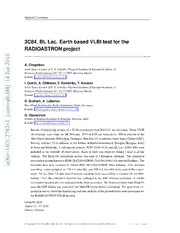Table Of ContentSoftwareCorrelator
3C84, BL Lac. Earth based VLBI test for the
RADIOASTRON project
1
1
0
2
A. Chuprikov
n
AstroSpaceCenterofP.N.LebedevPhysicalInstituteofRussianAcademyof
a
J Sciences,Profsoyuznaya84/32,117997,Moscow,Russia
4 E-mail: [email protected]
1
I. Guirin, A.Chibisov,V.Kostenko,Y.Kovalev
]
AstroSpaceCenterofP.N.LebedevPhysicalInstituteofRussianAcademyof
M
Sciences,Profsoyuznaya84/32,117997,Moscow,Russia
I
. E-mail: [email protected]
h
p
D. Graham,A.Lobanov
-
o MaxPlankInstituteforRadioAstronomy,Bonn,Germany
r
t E-mail: [email protected]
s
a
G. Giovannini
[
IstitutodiRadioastronomiadiBologna,Bologna,Italy
1
E-mail: [email protected]
v
2
8 Results ofprocessingofdata ofa VLBI experimenttitled RAPL01are presented. These VLBI
7
observations were made on 4th February, 2010 at 6.28 cm between the 100-m antenna of the
2
. MaxPlanckInstitute(Effelsberg,Germany),Puschino22-mantenna(AstroSpaceCenter(ASC),
1
0 Russia), and two 32-mantennasof the Istituto di Radioastronomiadi Bologna (Bologna, Italy)
1
inNotoandMedicina. 2well-knownsources,3C84(0316+413),andBLLac(2200+420)were
1
: included in the schedule of observations. Each of them was observed during 1 hour at all the
v
i stations. The Mark-5A registration system was used at 3 European antennae. The alternative
X
registrationsystemknownasRDR(RADIOASTRONDataRecorder)wasusedinPuschino.The
r
a Puschino data were recorded in format RDF (RADIOASTRON Data Format). Two standard
recordingmodes designed as 128-4-1(one bit), and 256-4-2(two bit) were used in the experi-
ment. AlltheMark-5AdatafromEuropeanantennaeweresuccessfullyconvertedintotheRDF
format. Then, thecorrelationfunctionwasestimated atthe ASC softwarecorrelator. A similar
correlationfunctionalsowasestimatedattheBonncorrelator.TheBonncorrelatorreadsMark5A
data,theRDFformatwasconvertedintoMark5Bformatbeforecorrelation. Thegoaloftheex-
perimentwastocheckthefunctioninganddataanalysisofthegroundbasedradiotelescopesfor
theRADIOASTRONSVLBImission
GAMOW-2010
August23-272010
Odessa,Ukraine
(cid:13)c Copyrightownedbytheauthor(s)underthetermsoftheCreativeCommonsAttribution-NonCommercial-ShareAlikeLicence. http://pos.sissa.it/
1. Results ofdata processing
The correlator estimates the visibility as a function of time and frequency. A phase of this
complexfunction isshowninFigures1,and2.
Figure 1: Visibility phase vs time for the Effelsberg-Medicina baseline. Scan no. 3 (2200+420). The
maximumintegrationtimeis2minutes
If a fringe rate (or fringe frequency) is still not compensated, there is a considerable phase
slope. This may be due to several effects. For instance, it could be considerable if there is some
instability of heterodyne at any antenna of a baseline. A slope restricts the coherence time which
isequaltotimeintervalcorresponding tothephasedriftof180degrees.
The correlator of ASC uses the special software module titled ARIADNA for estimation of
delay for any interferometer baseline and any interval of observational time. Then, there is a
possibility to compensate the residual delay as well as the residual fringe rate at the input of the
correlator.
Valuesofresiduals withrespecttothereference antennainEffelsbergwerethefollowing:
1. Residualdelayvaluesare:
•21.10+/-0.05mcsforthePuschinoantenna
•-42.810+/-0.007mcsfortheMedicinaantenna
•12.520+/-0.005mcsfortheNotoantenna
2. Residualratevaluesare:
•0.412+/-0.0005HzforthePuschino antenna
•0.007+/-0.0006HzfortheMedicina antenna
•-0.002+/-0.0005HzfortheNotoantenna
2
Figure 2: Visibility phase vs time for the Effelsberg-Puschino baseline. Scan no. 3 (2200+420). The
maximumintegrationtimeis0.3seconds
Values ofresidual delay and fringe rate werealmost constant intimeforeach antenna during
the observations. Thus, they could be compensated very easily inside the correlator. For exam-
ple, the dependence of visibility phase on time for the second scan (source is 2200+420, lower
frequency band,RR-polarization) isshownintheFigure3.
It is clear from Figure 3 that visibility phase values are between -280 and -140 degrees after
thecompensation. Suchtheresidualphaseoscillations arereliableandcanbecorrectedduringthe
secondarydataprocessing. Thevalueofresidualfringeratecanbeeasilyestimatedfromthephase
slopevalue(148.54795degreespersecond). Then,theresidualfringeratevalueisequalto0.4137.
Thisisclosetothevaluementioned above(0.412).
The Signal-to-Noise Ratio (SNR) was measured for each baseline. The dependence of the
Signal to RMS multiplied by 6 value on integration time for the data of scan no. 8 from the
Effelsberg-Noto baseline andRRpolarization isshowninFigure4.
It is clear from this figure, that the saturation of SNR takes place when the integration time
is more than 2 seconds. Thus, there is the serious restriction for this parameter value even for
European baselines, and its optimum value is about 0.3 second as mentioned above. There were
observationaldataforthesourcetitled0316+413(3C84)forall4antennae. A(u,v)-planecoverage
(Figure5)doesnotallowtoreconstruct thesourcemap.
Estimation of the visible angular sizes of 3C84 gives the value of about 11 mas (Figure 6).
Thisisinconsistent withthe3C84properties available inliterature (Asada,2000, 2006).
2. Conclusions
Thus,wecouldmakethefollowingconclusions :
3
A
B
Figure3: VisibilityphasevstimefortheEffelsberg-PuschinobaselineBEFORE (A)andAFTER(B)the
residualfringeratecompensation
1. TheexperimentRAPL01demonstratesthepossibilitytoconverttheMark-5AdataintoRDF
data. Antennae with different registration systems could be successfully used for the RA-
DIOASTRONmission
2. Theintegration timevalue isrestricted by1second duetoahighrateoffset atPuschino an-
tenna. Thesuccessful estimationofthecorrelationfunctiondemonstrates thepossibilities of
the ASCsoftware correlator tocompensate correctly the abnormally highvalues ofresidual
delaysandfringerates
3. ThedataattheendoftheASCsoftwarecorrelator arerelevantforthesecondary processing
4
3C84 Correlated amplitude / 6*RMS (Ef-No, RCP, 1 bit samling)
20
18
16
14
12
MS Ampl / 6RMS, LSB
R 10
6* Ampl / 6RMS,USB
S / 8
6
4
2
0
0 2 4 6 8 10 12 14 16 18 20
Integration Time (sec)
Figure4: Signal-to-Noiseratio(SNR)vstheintegrationtime
4. Thecalibrationprocedures ofthesoftwareknownasAstroSpaceLocatorallowreconstruct-
ingthevisibility function
5. The(u, v)-plane coverage forthe 3C84is notsufficient toperform the source imaging. The
valueofestimatedsourceangularsizeis11mas. Thisvalueisconsistedwiththe3C84prop-
ertiesavailable inliterature
Alltheresultspresented inthispaperarepreliminary.
Procedures and techologies used during the VLBA data processing also could be very useful for
processing ofdataoffutureSpaceVLBImissiontitledRADIOASTRON.
References
[1] K.Asada2000,Proc.OftheVSOPSymposium,19-21January2000,InstituteofSpaceand
AstronauticalScienceYoshinodai3-1-1,Sagamihara,Kanagawa229-8510,Japan,p.51
[2] K.Asada2006,PASJ,58,261
5
Figure5: (u,v)-planecoveragefor3C84
Figure6: Visibilityamplitudeversus(u,v)-radiusfor3C84
6

